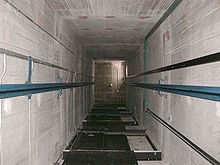
Surfing is a surface water sport in which an individual, a surfer, uses a board to ride on the forward section, or face, of a moving wave of water, which usually carries the surfer towards the shore. Waves suitable for surfing are primarily found on ocean shores, but can also be found in standing waves in the open ocean, in lakes, in rivers in the form of a tidal bore, or in wave pools.
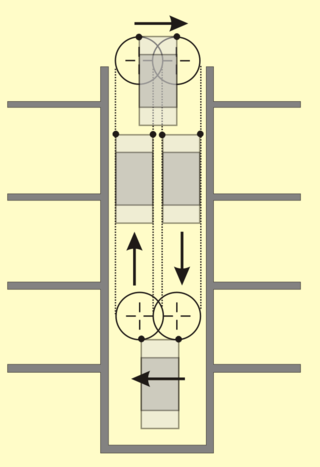
A paternoster or paternoster lift is a passenger elevator which consists of a chain of open compartments that move slowly in a loop up and down inside a building without stopping. Passengers can step on or off at any floor they like. The same technique is also used for filing cabinets to store large amounts of (paper) documents or for small spare parts. The much smaller belt manlift, which consists of an endless belt with steps and rungs but no compartments, is also sometimes called a paternoster.

Train surfing is typically a reckless, dangerous, and illegal act of riding on the outside of a moving train, tram, or other forms of rail transport. In a number of countries, the term 'train hopping' is used synonymously with freight hopping, which means riding on the outside of a freight train, while train surfing can be practiced on any type of train. This type of travelling can be extremely dangerous and even life-threatening, because there is a risk of death or serious injury due to falling off a moving train, electrocution by the power supply, colliding with railway infrastructure such as bridges, tunnels, station platforms, trackside buildings, railway signals or other trains, while riding outside off structure gauge on the side or on the roof of a train, or unsuccessful attempts to jump onto a moving train or off it. Today, the practice is illegal by statutes on many railroads in the world. Despite this, it is still practiced, especially on those railroads where the trains are overcrowded.
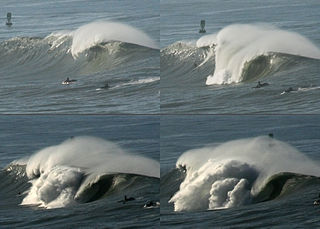
Mavericks is a surfing location in northern California outside Pillar Point Harbor, just north of the town of Half Moon Bay at the village of Princeton-by-the-Sea. After a strong winter storm in the northern Pacific Ocean, waves can routinely crest at over 25 ft (8 m) and top out at over 60 ft (18 m). Routinely, waves that break can be recorded on seismometers. The break is caused by an unusually shaped underwater rock formation.

The Twilight Zone Tower of Terror, or simply Tower of Terror, is a series of similar accelerated drop tower dark rides located at Disney's Hollywood Studios, Tokyo DisneySea, Walt Disney Studios Park, and formerly located at Disney California Adventure. The attraction is inspired by Rod Serling's anthology television series, The Twilight Zone, and takes place in the fictional Hollywood Tower Hotel in Hollywood, California. The Tokyo version features an original storyline not related to The Twilight Zone and takes place in the fictional Hotel Hightower. All versions of the attraction place riders in a seemingly ordinary hotel elevator, and present a fictional backstory in which people have mysteriously disappeared from the elevator under the influence of a supernatural element many years previously.

Laird John Hamilton is an American big-wave surfer, co-inventor of tow-in surfing, and an occasional fashion and action-sports model and actor. He is married to Gabrielle Reece, a former professional volleyball player, television personality, and model.

A lift hill, or chain hill, is an upward-sloping section of track on a roller coaster on which the roller coaster train is mechanically lifted to an elevated point or peak in the track. Upon reaching the peak, the train is then propelled from the peak by gravity and is usually allowed to coast throughout the rest of the roller coaster ride's circuit on its own momentum, including most or all of the remaining uphill sections. The initial upward-sloping section of a roller coaster track is usually a lift hill, as the train typically begins a ride with little speed, though some coasters have raised stations that permit an initial drop without a lift hill. Although uncommon, some tracks also contain multiple lift hills.
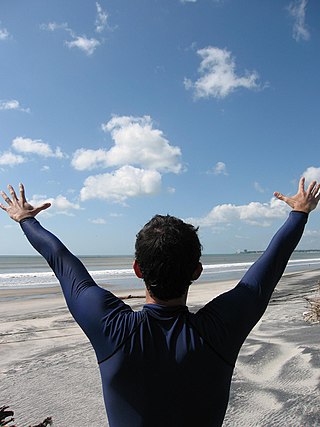
A rash guard, also known as rash vest or rashie, is an athletic shirt made of spandex and nylon or polyester. The name rash guard reflects the fact that the shirt protects the wearer against rashes caused by abrasion, or by sunburn from extended exposure to the sun, as sun protective clothing.

Roof and tunnel hacking is the unauthorized exploration of roof and utility tunnel spaces. The term carries a strong collegiate connotation, stemming from its use at MIT and at the U.S. Naval Academy, where the practice has a long history. It is a form of urban exploration.

Schindler Holding Ltd. is a Swiss multinational company which manufactures escalators, moving walkways, and elevators worldwide, founded in Switzerland in 1874. Schindler produces, installs, maintains and modernizes lifts and escalators in many types of buildings including residential, commercial and high-rise buildings.

The Lift is a 1983 Dutch science fiction horror film written and directed by Dick Maas. The plot concerns an elevator that mysteriously begins to function intelligently on its own, where victims who go near the elevator or use it are killed.
This is a summary of notable incidents that have taken place at amusement parks, water parks, or theme parks that are currently owned or operated by Cedar Fair. This list is not intended to be a comprehensive list of every such event, but only those that had a significant impact on the parks or park operations, or are otherwise significantly newsworthy. The term incidents refers to major accidents, injuries, or deaths that occur at a park. These incidents were required to be reported to regulatory authorities due to where they occurred. They usually fall into one of the following categories:
- Negligence on the part of the guest, such as refusal to follow specific ride safety instructions.
- A guest deliberately breaking park rules.
- A guest's known, or unknown, health issues.
- Negligence on the part of the park, either by a ride operator or maintenance staff.
- Negligence on the part of the attraction's manufacturer
- An Act of God or a generic accident that is not a direct result of an action or inaction on anybody's part.

River surfing is the sport of surfing either standing waves, tidal bores or upstream waves in rivers. Claims for its origins include a 1955 ride of 2.4 km (1.5 mi) along the tidal bore of the River Severn.

A dumbwaiter is a small freight elevator or lift intended to carry food. Dumbwaiters found within modern structures, including both commercial, public and private buildings, are often connected between multiple floors. When installed in restaurants, schools, hospitals, retirement homes or private homes, they generally terminate in a kitchen.
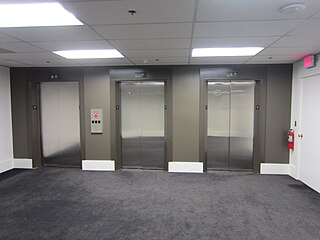
An elevator or lift is a machine that vertically transports people or freight between levels. They are typically powered by electric motors that drive traction cables and counterweight systems such as a hoist, although some pump hydraulic fluid to raise a cylindrical piston like a jack.

A surfboard fin or skeg is a hydrofoil mounted at the tail of a surfboard or similar board to improve directional stability and control through foot-steering. Fins can provide lateral lift opposed to the water and stabilize the board's trajectory, allowing the surfer to control direction by varying their side-to-side weight distribution. The introduction of fins in the 1930s revolutionized surfing and board design. Surfboard fins may be arrayed in different numbers and configurations, and many different shapes, sizes, and materials are and have been made and used.

This glossary of surfing includes some of the extensive vocabulary used to describe various aspects of the sport of surfing as described in literature on the subject.[a][b] In some cases terms have spread to a wider cultural use. These terms were originally coined by people who were directly involved in the sport of surfing.

Teahupoʻo is a village on the southwestern coast of the island of Tahiti, French Polynesia, in the southern Pacific Ocean.
